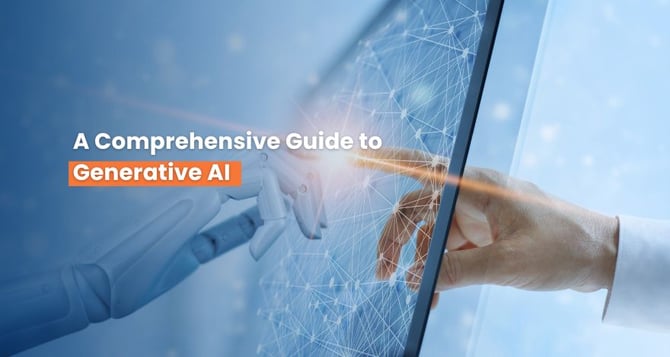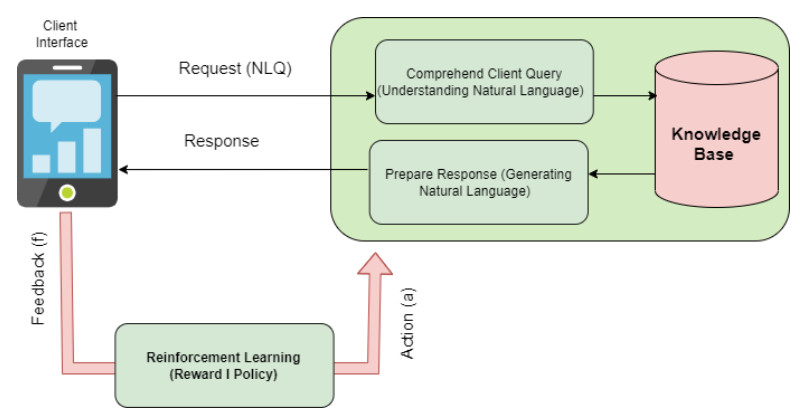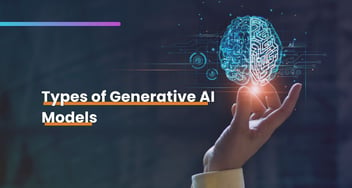What is Generative AI? A Comprehensive Guide
Is your company fully utilizing generative AI? You are losing out on fantastic chances if you don't utilize generative AI systems. Learn about the definition of generative AI, the industries in which it may be used, the most often used models, and the reasons you should implement it.

Gone are the days when businesses had to invest loads of money and time strategizing for their future growth. The 21st century is an era of fast-growing tech, shaping the path for swift business advancement.
In this competitive world, where several businesses are being launched in the same industries, coping with the latest trends and needs is no longer an option. One such aspect is Generative AI.
Did you know that as per the studies, the market size in Generative AI is projected to reach a volume of US$207.00 billion by 2030?
So, whether you are a startup or an established business, understanding the concept of Generative AI is a must.
This blog will explain to you in detail the idea of Generative AI, the types and industries that can benefit from it, and how your business can adopt this technology easily.
Key Takeaways:
- Generative AI is projected to reach $207 billion by 2030, with an investment of $27 billion by significant investors like Microsoft.
- Chatbots backed by Generative AI can reduce support expenses by up to 80%. The same reports also highlighted that it enhances revenue by 15%.
- Generative AI models like GPT-3, StyleGAN, ChatGPT, Bard, and DALL-E provide several solutions and can improve speed and accuracy.
- The technology also can transform several industries like healthcare, marketing, manufacturing, finance, and media industries with features like innovative content creation, fraud detection, and automation advantages.
What is Generative AI - Explained in Simple Words!
Generative AI is an emerging subdomain of AI. Unlike traditional AI, which focuses on classifying or analyzing existing data, Generative AI creates new data that looks like the original and appears similar to what humans produce. To do this, Generative AI models use deep learning, neural networks, and natural language processing. These advanced techniques help the models learn and mimic patterns found in large datasets.
To create content, an LLM is given a set of parameters through a query or prompt. When generative AI tools interact with users conversationally via prompts, it becomes easier for users to generate content. Generative AI can greatly improve productivity for both individuals and organizations. Despite presenting some real challenges and risks, businesses are eagerly exploring how this technology can enhance their workflows. But before moving forward, let us see how it works.
How Generative AI Works?
Generative AI learns from data using machine learning. Unlike traditional machine learning models that only identify patterns and make predictions, generative AI goes further. It not only learns from the data but can also create new examples that mimic the original data’s characteristics.
The main steps to using generative AI models are similar across different types, which will be explained in more detail below.
Data collection: To create new content, first collect a large dataset of examples. For instance, gather images if you want to generate realistic pictures, or collect text if you aim to create coherent sentences.
- Model training: The generative AI model uses neural networks. Generative AI learns from a collected dataset to understand the patterns and structures in the data.
- Generation: After training, the model can create new content. It does this by taking samples from the latent space or using a generator network, depending on the type of model. The content generated reflects what the model learned from the training data.
- Refinement: The generated content may need to be improved or adjusted depending on the task and how it will be used. This helps to enhance quality or meet specific needs.
Generative AI Model Architectures and Their Evolution
Generative AI models are advanced deep learning systems that can create content on demand. Advances in deep learning and neural network designs have brought generative AI to the forefront of attention, enhancing output quality. Over the past twelve years, several key model types have emerged:
- Variational autoencoders (VAEs) have helped improve image recognition, natural language processing, and anomaly detection.
- Generative adversarial networks (GANs) and diffusion models have made previous applications more accurate and have enabled the creation of realistic images.
- Transformers are the deep learning architecture behind the leading foundation models and generative AI solutions used today.

Want a complete insight on the types of Generative AI models? Explore our detailed blog here Types of Generative AI Models and Its Applications!
Generative AI Models That Can Benefit Your Business
Several Generative AI models can help help your company with text creation, image generation, and more. With an AI image generator, you can effortlessly produce high-quality visuals tailored to your brand's needs
Generative AI models leverage advanced ML techniques to understand and replicate patterns present in various forms of data.
For instance, GPT-3 by OpenAI uses large-scale pre-training on diverse text sources to comprehend and generate human-like language, enabling tasks such as translation, dialogue generation, and creative writing.
Similarly, generative models like StyleGAN and DALL-E apply complex algorithms to understand and create visual content, demonstrating the AI's ability to generate realistic and diverse images based on specific input or textual descriptions.
1. ChatGPT
Developed by OpenAI, ChatGPT is a state-of-the-art conversational AI model meant to communicate and comprehend human-like. ChatGPT integrates a wide range of pre-existing knowledge and linguistic patterns gathered from enormous volumes of text data by utilizing the Generative Pre-trained Transformer (GPT) architecture.
It helps it understand and respond appropriately, carrying on logical and situationally appropriate dialogues about a variety of subjects.
The General Architecture of ChatGPT

Source: Arxiv
A major advancement in natural language processing, ChatGPT shows how AI can comprehend and contribute to complex human communication. To harness this power, businesses can embed a ChatGPT-powered chatbot on their website to enhance customer service or provide instant information.
- Engage in human-like conversations
- Generate text based on prompts
- Supports dialogue generation
- Assists in creative writing and storytelling
2. Bard
Bard is an advanced AI model developed by Google. It is designed to generate coherent and contextually relevant text based on user prompts. Due to its GPT-3 architecture, Bard can produce high-quality and diverse written content, ranging from creative writing to insightful responses in a human-like manner.
The highlight of Bard is that it can help with a variety of linguistic activities due to its ability to generate and comprehend language.
- Engage in dialogue and conversation
- Aid in generating diverse written content
- Provide insightful and human-like responses
- Contribute to a wide array of linguistic tasks
3. Dall-E
Dall-E is another innovative GenAI model advanced by OpenAI that can create realistic images and videos from text descriptions. Through the use of extensive generative techniques, DALL-E can interpret and convert textual cues into conceptually meaningful and visually stimulating imagery. This progressive technology has created great possibilities for designers, artists, and content creators.
- Creating conceptually aligned visual content based on input text
- Generating diverse and contextually relevant images based on textual descriptions
- Generating artwork based on specific input prompts
- Understanding and translating textual prompts into visually rich images
Using such platforms in your business will help you speed up the process of creating content, images, and videos. By collaborating with the right Generative AI development company, you can ensure that you adopt these models efficiently.
Numbers Prove Generative AI is the Future
Generative AI models like ChatGPT, Stable Diffusion, and Midjourney have captured the interest of business leaders worldwide. In fact, A new survey by Salesforce found that 67% of IT leaders plan to focus on generative AI for their business in the next 18 months. Among them, 33% see Gen AI it as a top priority.
Are you still confused about why you should impart Generative AI tools in your daily business operations? To understand the current GenAI trends, here are the numbers that prove Generative AI is a must for businesses across all industries:
- The Generative AI market is expected to grow nearly 100 times in the next decade.
- In 2023, $27 billion was invested into generative AI startups led by Microsoft.
- Communication with customers is crucial for business success, and chatbots powered by Generative AI have been proven to reduce support costs by up to 80%. This market is expected to reach USD 1.25 billion by 2025.
- As per a survey conducted by IBM, 35% of respondents believe that Generative AI is one of the most popular technologies to bring greater changes to businesses.
These numbers and reports prove that companies are sure to benefit from Generative AI due to its ability to perform tasks in less time and with the least human intervention.
See How We Delivered 300% ROI with AI
Discover how our Generative AI solutions helped a company like yours achieve massive growth.
No matter what industry your business is in, this technology can do wonders for your progress. The section below explains how Generative AI plays a crucial role in several industries.
What are the Use Cases of Generative AI?
Generative AI is applied in numerous industries to create different types of structured data and content like text, imagery, videos, and music. From the healthcare industry to education, manufacturing, and marketing, the use cases of Generative AI can be seen everywhere. Some of these include:
- Content Creation: Text, photos, and videos can be produced in a variety of ways using Generative AI, making content creative and quick.
- Art and Design: Artists leverage the power of Generative AI for creative purposes, generating unique artwork designs and even aiding in the style transfer of images.
- Marketing: The technology is used to create personalized content and targeted ads to boost customer engagement.
- Natural Language Processing (NLP): Generative AI also powers AI chatbots, virtual assistants, and language translation services to enhance communication and language understanding.
- eCommerce: Product suggestions are optimized, user experiences are personalized, and the system generates material for marketing and product descriptions.
- Finance: In the finance sector, Generative AI helps predict market trends, analyze investment strategies, and improve fraud detection.
- Gaming: By enabling interactive storytelling and producing dynamic in-game features, procedural content creation improves gaming experiences.
Additionally, using the best QR code generator allows developers to seamlessly integrate scannable codes into games, unlocking hidden content or exclusive rewards to enhance player engagement.
Top Benefits of Generative AI
Due to its range of services, Generative AI is of great help across all industries. From interpreting complex data to creating engaging content, videos, and images, Generative AI models hold a lot of capabilities.

Some of the top benefits of Generative AI include:
- Miximizes content creation efficiency, leading to personalized and targeted campaigns.
- Leads to better cost savings and resource optimization through streamlined processes.
- Enables tailored and personalized user experiences through custom content generation.
- Revolutionizes design processes by generating conceptually rich visual content.
- Augments decision-making capabilities by providing rich insights and predictive analysis.
- Automates repetitive and labor-intensive tasks to enhance efficiency.
Limitations of Generative AI
Generative AI is a great help for businesses across all industries, but it comes with many limitations. While it automates routine tasks and makes business operations quick, on the other hand, its ability to handle novel situations can be limited. Some of the biggest limitations of Generative AI include:
- It relies on high-quality and large-scale training data that, at times, may not be available.
- Unintentionally adopting biases from training data might result in biased outcomes for the models.
- The judgments made by generative AI models, which are sometimes referred to as "black boxes," can be difficult to comprehend and defend.
- Manipulations or false inputs might compromise the results of these models.
- Certain patterns from the training data may be captured by generative AI models too effectively, resulting in overfitting and a lack of generalization.
Role of Generative AI in Various Industries
The impact of Generative AI on human intelligence can be seen everywhere. From the finance sector to healthcare, manufacturing, and so on, this groundbreaking technology makes business processes easy, error-free, and fluent.

The applications of Generative AI in various industries help startups and businesses grow to their full potential.
1. Healthcare
The healthcare sector has a lot of potential for Generative AI that can transform patient care, medication development, medical imaging, and more. These models can help with precise diagnosis and treatment planning by interpreting complicated medical data. The Generative AI in healthcare market is expected to reach USD 17.2 billion by 2032.
Examining specific patient data can also help customize medicine by facilitating the creation of innovative medication molecules.
2. Marketing
By creating tailored and interesting content at scale, such as relevant product descriptions, ads, and social media posts, depending on audience interests and behavior, Generative AI has a great deal of potential to improve marketing initiatives. It can also help with the creation of visually appealing and relevant visual material, such as videos and photos, that is customized for certain marketing campaigns.
3. Manufacturing
Through the creation of creative concepts, simulations, and predictive models, Generative AI significantly improves product design, prototyping, and production processes for the manufacturing sector. With the use of this technology, it is possible to create intricate 3D models and simulation tools that improve product testing and development.
As per a report by Deloitte, predictive maintenance technology in manufacturing can help enhance productivity by 25% and reduce breakdowns by 70%. It leads to increased manufacturing efficiency, lower prices, and a greater degree of creativity in product design and production.
4. Finance
The finance sector can also gain significant advantages from Generative AI as it improves fraud detection systems, produces tailored financial insights, and automates operations connected to data analysis and compliance. These developments facilitate quicker decision-making, risk assessment, and the creation of complex financial models, which eventually enhance operational effectiveness, customer satisfaction, and regulatory compliance in the financial industry.
5. Media
If you run a business in the media industry, Generative AI is a must. From streamlining content creation to optimizing audience engagement through personalized content generation, using Generative AI can do wonders. Additionally, it can also improve workflows by automating several tasks like transcription, translation, and subtitling, ultimately boosting creativity, efficiency, and scalability.
Stop Reading, Start Building with AI
Your next breakthrough is a click away. Partner with our team to bring your most ambitious AI projects to life, from concept to launch.
Top 5 Challenges Faced by Businesses in Adapting Generative AI
Often, businesses face several challenges when it comes to implementing Generative AI in their everyday operations. Here are the top five challenges and how you can overcome them to maximize business value.
1. Data Privacy and Security Concerns
A significant quantity of labeled data is frequently needed for training AI models. Data security and privacy are issues that arise while handling private or sensitive data. One of the biggest challenges is making sure that data privacy laws are followed and that possible breaches are prevented.
2. Ethical and Bias Issues
Training data may contain biases that generative AI models unintentionally pick up on and reproduce. To guarantee that AI systems are impartial and fair, businesses must actively address ethical issues. It includes putting in place procedures to reduce biases during model building as well as ongoing monitoring and auditing.
3. Interpretable AI and Lack of Transparency
Another challenge faced by companies while adapting Generative AI is that many generative AI models—especially deep learning models—are sometimes referred to as "black boxes." It is difficult for organizations to understand and justify the judgments made by these models due to their lack of interpretability.
4. Skill Gap and Talent Shortage
Skill gaps and talent shortages are some of the biggest challenges faced by businesses in their early stages. Implementing Generative AI requires a workforce proficient in ML, data science, and related domains. For businesses to close the skill gap and successfully apply Generative AI technologies, they must spend time educating current employees or luring in fresh talent.
5. Integration with Existing Systems and Processes
Lastly, it can be challenging to integrate Generative AI tools into current commercial systems and procedures. There can be integrating issues if more recent AI technologies are incompatible with legacy systems. Companies can engage in updating and changing existing infrastructure to enable a smooth integration of Generative AI.
Also, it requires plenty of time, money, and resources for businesses to adopt Generative AI in their daily operations. Hence, collaborating with a Generative AI company can help brands quickly accommodate this technology with their existing systems.
Just like our Generative AI development services at Signity are designed to help companies adapt Generative AI through the latest tech stack like GPT 3.5, AI frameworks such as PyTorch and TensorFlow, and Cloud platforms like AWS and Azure.
The Future of Generative AI
The future of generative AI is indeed promising. Even analysts predict massive growth ahead as more models are trained to enhance their capabilities. The global generative AI market is projected to reach $109.4 billion by 2030, growing at a nearly 30–37% CAGR.

As we move into 2026, the next wave of transformation will come from agentic chatbots. Agentic AI chatbots are the AI assistants that don’t just respond to queries but act autonomously toward long-term goals. Several large language models like ChatGPT’s new AI Agent Mode, Gemini, and Claude are already integrating with third-party apps to take multi-step actions without human help. Gartner predicts that by 2028, about one-third of enterprise software applications will have agentic AI features. These advancements will help businesses reduce delays, make better decisions, and automate tasks more intelligently on a larger scale.
Privacy-focused generative AI is becoming more important. As concerns about data safety grow, companies are moving towards large language models that process information on devices or in their own facilities to keep sensitive data safe. In fact, global companies like Apple are leading the way by prioritizing privacy-first AI.
Generative AI in gaming is an exciting new area. Developers are now making games where storylines change based on player choices. AI-generated characters can have realistic conversations and act in unexpected ways. This helps create more immersive experiences for players.
In the next few years, generative AI will shift from an experimental tool to a necessary strategy for businesses.
Embrace Generative AI Revolution for Business Growth
The faster your business embraces the power of Generative AI, the better the results will be.
From enhanced productivity to improved customer experiences, data-driven insights, cost savings, and competitive advantage, Generative AI services is the need of the hour.
Connect with our team at Signity and get started with leveraging the power of Generative AI.
Not sure how AI fits into your business? Let's talk!
Book a quick 15-minute call with our AI experts to find out how to use AI for your business challenges.
Frequently Asked Questions
Have a question in mind? We are here to answer.
What is generative AI in simple terms?
![]()
What is the difference between ChatGPT and generative AI?
![]()
While Generative AI covers a wider variety of capabilities, such as picture and music production, among others, ChatGPT is a specialized application of Generative AI that focuses on producing human-like text answers for conversational purposes.
What are the principles of Generative AI?
![]()
Generative AI emphasizes the safe, ethical, and responsible use of technology while teaching models to recognize and reproduce patterns in data to generate unique outputs.
What is the downside of generative AI?
![]()
The drawbacks of Generative AI include potential ethical issues, such as the production of incorrect or biased information and the possible misuse of created outputs.
What is the most famous generative AI?
![]()
Most people probably know Generative AI from OpenAI's GPT-3, which can produce text that seems like it was written by a human being on a variety of subjects and in a range of contexts.
What is the difference between generative AI and AI?
![]()


%201-1.webp?width=148&height=74&name=our%20work%20(2)%201-1.webp)


.png?width=344&height=101&name=Mask%20group%20(5).png)
















